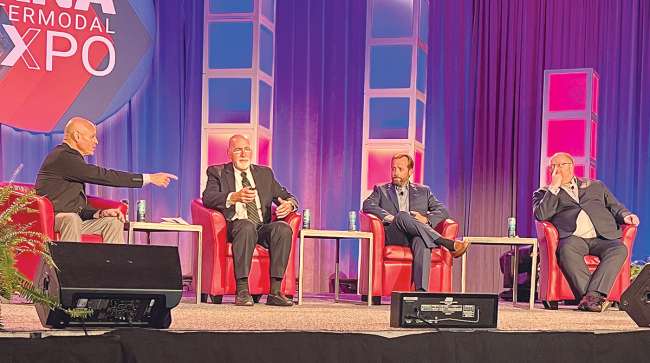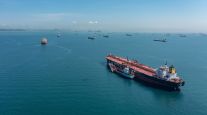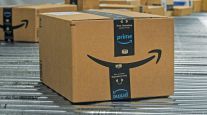Senior Reporter
Transportation Stakeholders See Slow Growth in 2024

[Stay on top of transportation news: Get TTNews in your inbox.]
LONG BEACH, Calif. — As 2023 heads toward the last quarter, shippers and transportation companies hope that the fall peak season pushes the industry out of the freight recession, a leading transportation official said Sept. 12 at IANA Intermodal Expo.
Lawrence Gross, president of Gross Transportation Consulting, told the more than 2,000 attendees both the trucking and freight rail sectors are still in a slump, but the worst may be over.
“Domestic freight bottomed out at the beginning of the year and has been kind of bumping along through May, and has actually started to trend upwards in a pretty seasonal manner and I’m hopeful we’ll continue to see that,” Gross said. “With regard to the international side, we are still in a deep hole, down 15.7% year-over-year as of July. It’s not a terrific picture, but it’s not a bad picture.”
The so-called peak season runs from late summer and into the fall, and it’s the busiest time of the year in supply chains as retailers rush in clothing, furniture, electronics and holiday goods. The busiest week in this surge is the last week of September. Gross said 2023’s peak season will be slightly below the 10-year average of an increase of 6.4% in freight.
With regard to the international side, we are still in a deep hole, down 15.7% year-over-year as of July.
Lawrence Gross, president of Gross Transportation Consullting
“We’re about 4% above average this year,” Gross said. “But where I do have some concern here, right up until Labor Day we have had a tail-off. This is an indication the peak season may be a bit subpar.”
Gross said there are opportunities for intermodal companies to grow by becoming more competitive against the trucking industry, especially those businesses that move longhaul dry van and refrigerated freight.
“We spend a lot of time thinking about the overall macro environment; actually, this is the biggest opportunity because we control our competitiveness against trucking and there is a giant opportunity to control our own destiny,” he said. Gross pointed out that if intermodal had held the same market share it had in 2017, those companies would have an additional 1.6 million domestic loads worth $4 billion in revenue.
Panel moderator Evan Armstrong told the audience he is cautiously optimistic the worst may be over and slow growth is coming soon.
“It’s very hard to compare this year to the last two, given what happened to us in 2021 and 2022. This year is a little more challenging,” said the CEO of Armstrong & Associates. “I think we’ll get into a more normal growth pattern in 2024 and then into 2025.”
Tim Denoyer, ACT Research vice president and senior analyst, said capacity in the trucking industry has tightened in the past several months, in part because of the closing and bankruptcy of LTL carrier Yellow Corp. and the economy showing signs of avoiding a recession. He said those factors help trucking.
Will you be at IANA’s 2023 Intermodal EXPO in Long Beach, California? Don't miss the Inside Intermodal session with ACT's Tim Denoyer and other industry analysts as they provide their view of what’s happening and where things are headed. #ianaexpo @Intermodal pic.twitter.com/fAeswtLr8G — ACT Research (@actresearch) September 7, 2023
“The volume has been contracting for a while, and driver availability has been good for a while. And the industry is starting to tighten up on the capacity,” Denoyer said. “I do think a lot of the Yellow drivers will take their pensions, and the industry will tighten and rates will start to rise. We are nearing the turn of the cycle, bouncing on the bottom.”
Ocean shipping expert Alan Murphy, CEO and founder of Sea-Intelligence, gave an overview of the post-pandemic transportation economy.
“Globally, basically we’re back to 2019. What does that tell you? That massive volume boom during the pandemic was wiped away,” he said. “That boom is gone. It’s back to zero. The pandemic volume came and went, and we’re back to where we were four years ago.”
The pandemic volume came and went, and we’re back to where we were four years ago.
Alan Murphy, CEO and founder of Sea-Intelligece
The four experts agreed that the international shipping market, especially with cargo from China, has been the biggest drag on the freight industry the past year, while domestic transportation has held its own.
“I think the story is a little bit better on the domestic side,” Gross said. “There will be some upward movement; it will be very modest. I think there will be enough juice there so that overall domestic volume will be positive year-over-year and the fourth quarter will be in the black. But I’m not looking for anything more than low-single-digit growth in 2024.”

Transport Topics' Seth Clevenger, Michael Freeze and Mike Senatore dissect the new Top 100 list of the largest private carriers, including how fleets are adapting to this softened market. Tune in above or by going to RoadSigns.ttnews.com.
Murphy said the shipping lines massively overbuilt during the pandemic and now the industry has too many ships in a down market.
“I’m very pessimistic for not just the short term, but medium term when it comes to container shipping,” he said. “It’s hard to feel sorry for the shipping lines, because all of these wounds are self-inflicted, and everyone said ‘don’t order more vessels’ and there was a massive shortage of vessels during the pandemic.
“But let’s remember: It takes three years to build a new vessel, and that massive oversupply is going to stick with us, unless there’s a boom in demand.”
Want more news? Listen to today's daily briefing below or go here for more info:




